The following is the first in a blog series documenting my journey along the Via Francigena pilgrimage route to Rome. Joining me along the way is my boyfriend, Adam.
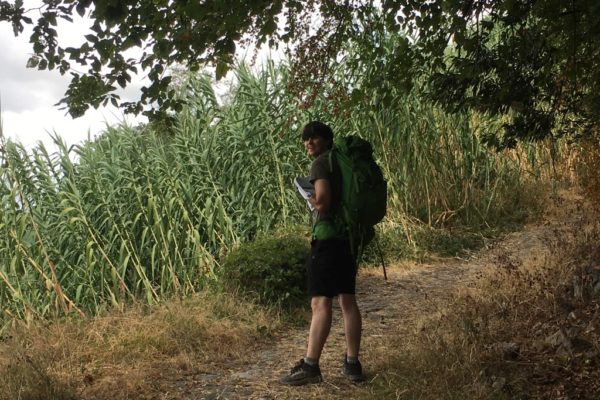
Read about the impetus of the trip here.
9 AUGUST: Oxford – Fidenza [travel day]
A bit of a frantic scramble getting out of Oxford this morning. Note to self: do not attempt to move out of an apartment and depart for a two-month trip in the same day. It leads to silly forgetfulness, an irked boyfriend, and stress dreams about packing. After oversleeping the alarm by about an hour, missing our earlier bus, and then sitting in unexpected traffic on the way to Gatwick, things were off to a tense start. Fortunately, we made the flight with time to spare, and were finally off to Italy.
Upon arrival in Milan we picked up our pilgrim passports at Gogol’Ostello and then snagged our trains to Fidenza. Given that we’d be arriving late and getting prepared for our journey, we opted to book a hotel rather than the cheaper pilgrims’ accommodation. Hotel Fidenza was full when I contacted them, but the manager very kindly offered to reserve us a room at the nearby Hotel Astoria. We were very pleased to find, once our travel day finally drew to a close, all the 3-star luxury money can buy: most importantly, a hot shower. Washed, repacked, and well ready to rest, we set our alarms and went to sleep, eager to start our pilgrimage bright and early the next morning.
10 AUGUST: Fidenza – Medesano (23km)
36,000 steps
5am: The alarm sounds and we’re brushing our teeth and packing our bags with bleary eyes. After an unexpected (but very welcome) shot of espresso kindly proffered by the woman who was setting up the hotel’s breakfast buffet, we made our way out into Fidenza’s quiet streets. It was a clear, mild morning, and getting to the starting point of our guidebook’s instructions (we’re using the 2014 Chin & Gallard Lightfoot Guide) allowed us a brief glimpse of some of Fidenza’s landmarks, namely the cathedral and the Palazzo Comunale.
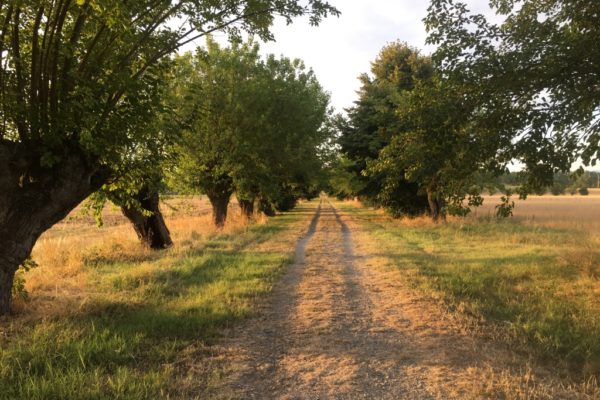 A pleasant walk through the city’s tree-lined outskirts followed, and the feeling that we were now truly on our way began to set in. Over the next couple of hours the route wound us through woods and farmland, up the gradual ascent to Costamezzana. Here we stopped for a breakfast of coffee and croissants (I will say this is one way in which Spain has Italy beat. Don’t get me wrong, I love a good croissant, but it’s not as sustaining as a hearty slice of tortilla.) at the bar just down the street from the church of San Pietro Apostolo.
A pleasant walk through the city’s tree-lined outskirts followed, and the feeling that we were now truly on our way began to set in. Over the next couple of hours the route wound us through woods and farmland, up the gradual ascent to Costamezzana. Here we stopped for a breakfast of coffee and croissants (I will say this is one way in which Spain has Italy beat. Don’t get me wrong, I love a good croissant, but it’s not as sustaining as a hearty slice of tortilla.) at the bar just down the street from the church of San Pietro Apostolo.
We weren’t the only backpackers to stop here and the place was clearly accustomed to entertaining pilgrims—information on the Via Francigena lined the walls and the bar’s owner gave us a very warm welcome. The guidebook lists Costamezzana as the end of a stage in its own right, but as we had only walked 11.6km and it was still just 9am, we wanted to continue on to Fornovo. Rejuvenated and recaffeinated, we said our goodbyes and set off for the next ⅔ of our hike.
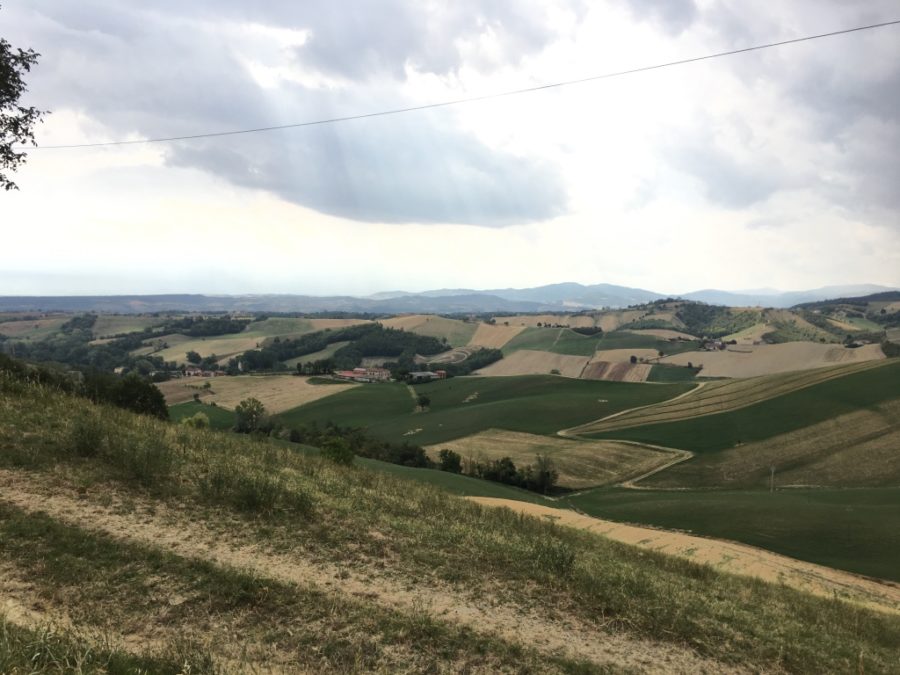
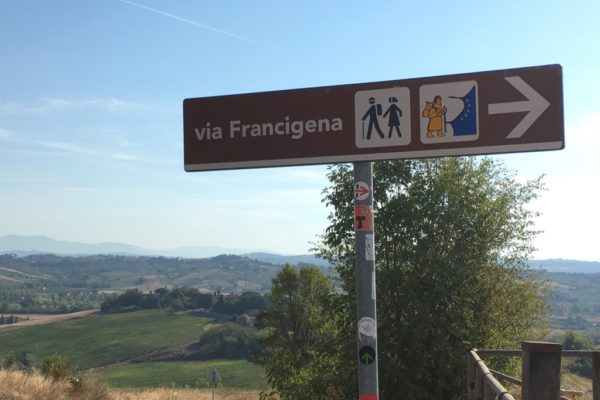
The weather held for much of the rest of the morning, warm but mitigated somewhat by the intermittent cloud cover. This was a good thing, as the rest of this day involved much more arduous ascents and descents through farm country (mmm… eau de cow). Not helping matters was the fact that signage for the trail was very hit-or-miss and the guidebook instructions were, at times, less than clear. We took several unplanned detours to the tune of a few extra kilometers and a handful of unnecessary climbs. The echo of thunder threatened storms for a few hours, but aside from a brief teasing of drizzle, we stayed dry.
After a particularly difficult trudge down and then back up through a valley field, we finally stumbled into Medesano in the mid-afternoon. Exhausted and hungry, we collapsed into the first bar we found, devoured a pair of sandwiches, and took a moment to regroup. It was clear we weren’t going to make it to Fornovo: we were looking at another 12km (with a strenuous uphill section) ahead of us, it was already the time when we thought we’d be arriving, and both of us were pretty spent. We decided to call it a day and stay in Medesano, assuming we could find accommodation. The guidebook mentioned there would be a pilgrim hostel in the town, although frustratingly neither it nor its street were listed on Google Maps. Adam waited with our bags while I went off in search of the place. Luckily, in the small town this didn’t take too long and, after a terse encounter with the hostel manager (who did not seem to have much verve for his line of work), we paid our donation, got our pilgrim passports stamped, and settled into the bunk beds of our room.
Having showered, washed our clothes, and taken a glorious nap, we did some reassessment of our route. It was clear that some of the longer stages planned weren’t going to be feasible—the distances themselves might be, but not when you factored in altitudes (who knew the foothills of the Apennines would be so…hilly?) and the weight on our backs. And while it would be one thing for a medieval pilgrim to just take some extra time to finish his or her pilgrimage, having trains and flights to catch at the end makes timing somewhat more tight. In the interest of not being rushed as we approached Rome, we decided to take the train ahead a few days in our schedule, to Sarzana, and begin again. Better to adapt our goals than burn out part of the way to our destination.
Our new plan in place, we set off for dinner and beers at Meat & Co. (steak burgers with melted scamorza? Yes please.), to recharge with a delicious and substantial meal after a hard first day.
11 AUGUST: Medesano – Sarzana – Fosdinovo (—; 10km)
16,000 steps
Exactly two trains depart Medesano each day in the direction we were headed: one at 8:50am and another at 8pm. While the town has its charms, we weren’t exactly keen to spend another day there. Needless to say, we made sure to arrive at the train station well in advance. Given the infrequency of even regional trains I suppose in hindsight it’s not completely shocking that the station we found looked to be, by all accounts, abandoned. Several perplexed minutes of wandering and sign-deciphering later, we determined that we were in fact in the right place—there just wasn’t a soul anywhere in sight. Thank god for international data roaming, which let me hastily book our tickets online, and, much to our relief, the announcement board chirped to life a few minutes before our train arrived.
We had a brief change in Fidenza (nothing like a very quick backtrack to realize how little ground you’ve covered!) and then a leisurely ride to Sarzana. It rained most of the way there, so I can’t say I was sorry not to be outside walking uphill in mud, and the trip through the mountains was beautiful (made more amusing by an intermittent game of: “See that hill? We would have had to climb that!”). We reached Sarzana around midday but quickly discovered that there was no last-minute lodging to be had in the city. Adam managed to book us a room in a B&B in the nearby town of Fosdinovo, which would have been on our route the next day anyway. So, after lunch and a friendly conversation with a vacationing Belgian named Claude, we set off.
Fosdinovo is only about 5km from Sarzana. Problem is: that 5km is largely up a punishing incline which, in the heat of the day and on the shoulder of the road, felt much longer than it really was. When we were still about an hour’s walk away, we stopped off to ask about a local bus or train of a young couple lounging by a backyard pool. It turned out that they were French students renting an AirBnB and didn’t know the area. Luckily, the owner was home and, while she regretfully explained that the bus was infrequent and taxis weren’t really a thing in that area, she very generously offered to drive us the rest of the way up the hill. Relieved and profusely grateful, we piled into the car and a short 10 minutes later we arrived at Casa Virgilio.
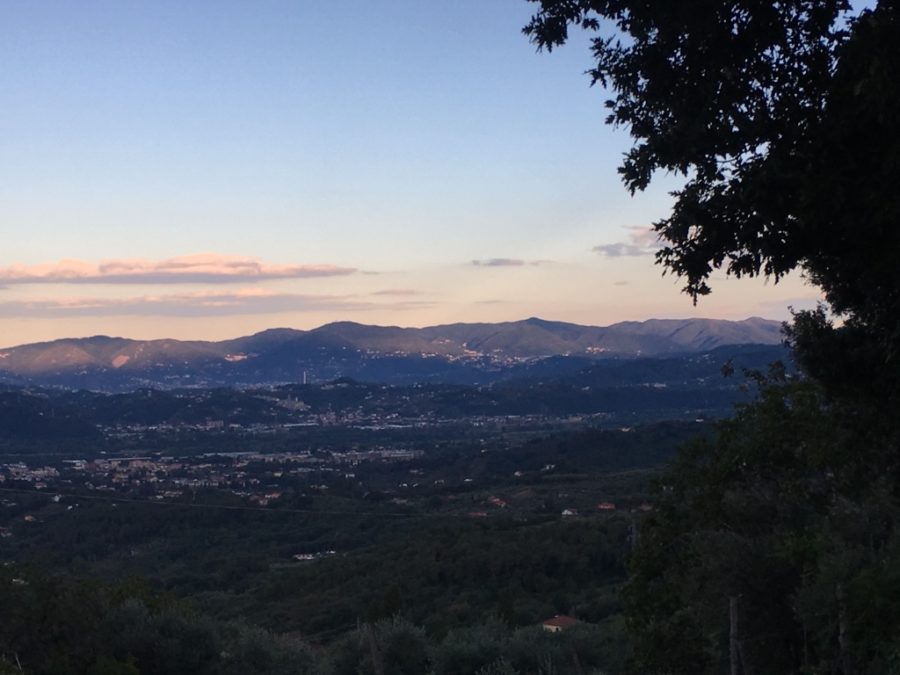
It was a charming B&B with lots of privacy (the room was sort of its own annex with a separate entrance from the rest of the house), and was very clean and thoughtfully arranged. The family and their several dogs and cats gave us a very hospitable welcome and, after we had settled in, suggested we visit a restaurant, Terra della Luna, just up the road for dinner. Not only did it give us a glimpse into the local culture (the tight-knit communal identity was immediately apparent—everyone seemed on very familiar terms with the establishment owners and each other), but it was the sort of place where there are no menus: the chefs just make whatever strikes your fancy and is available. At our waiter’s suggestion we enjoyed a feast of paste stuffed with fresh soft cheese, prosciutto, and roasted vegetables, a plate of ravioli al ragu, beautiful house-made red wine, and gelato. We left after a couple of hours completely full, pretty tipsy, and feeling very thankful for our fortuitous find. The first couple of days of our trek may not have gone as planned, but here was the type of incredible experience one hopes for on a holiday in Italy.
12 AUGUST: Fosdinovo – Pietrasanta (33.5km)
57,000 steps
Our guidebook presented us with two options this morning: take the standard but very steep route to Massa, or take the longer but flatter detour by the seaside all the way to Pietrasanta. Climb a mountain or get to walk along the shore of the Mediterranean? The latter seemed like a no-brainer.
The morning was a clear and pleasant walk through suburban residential neighborhoods and the going was fairly easy until we hit a couple more directional snags, due to changes in the route since the guidebook was published, and downright confusing instructions. It took us about an hour to get back on the trail, which led us down to a seaside walk through various marina towns. Though we, two hot and sweaty travelers in heavy boots, watched beachgoers running through sand and splashing in the waves with great envy, we had the gorgeous vistas of mountains to our left and the sparkling Mediterranean to our right to distract us.
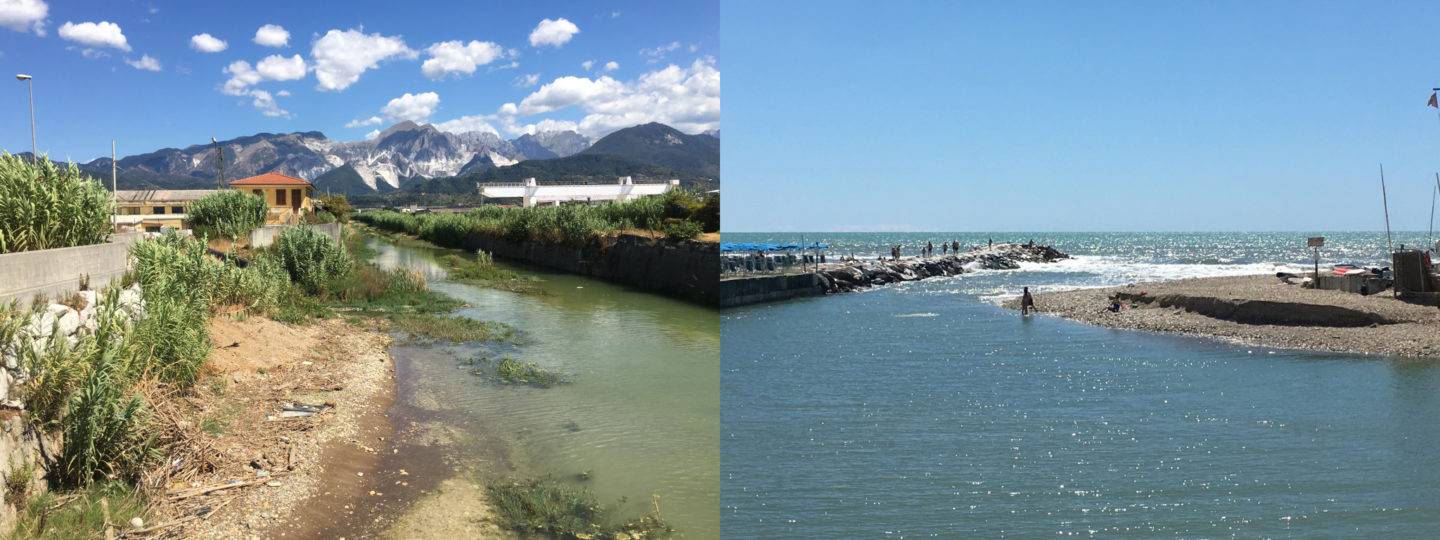
What we discovered, about halfway through our walk, was that our seemingly picture-perfect route solution came with a cost: many many hours on hard pavement beneath the unforgiving sun. As the day wore on our energy and our spirits flagged. The road felt infinite, and the more weary and hurt we became, the longer the walk took. By the time we limped into Pietrasanta (a beautiful town, thought we weren’t much in the mood to notice) and hauled ourselves up the stairs to the pilgrims’ hostel, we felt broken. Adam’s feet were covered in blisters. It looked like I was going to lose a toenail. We were both sunburned and our muscles were screaming at us. No doubt, it had been a rough day: physically, mentally, and emotionally. Our only consolation was that it was over now and tomorrow’s hike would pale in comparison. Exhausted and hoping sleep would heal all, we went to bed early and closed this difficult chapter.
13 AUGUST: Pietrasanta – Camaiore (8.5km)
24,000 steps
Upon waking up early and determining that our legs still functioned, we set off in the dark morning hours. We weren’t sure how fast our pace would be after the previous day’s ordeal and we wanted to spare ourselves from as much of the heat of the day as possible. Only one detour today (unfortunately once again up a hill: the agricultural Monte Prati), but once we cleared the ascents the walk to Camaiore was a sequence of bike trails and riverside paths.
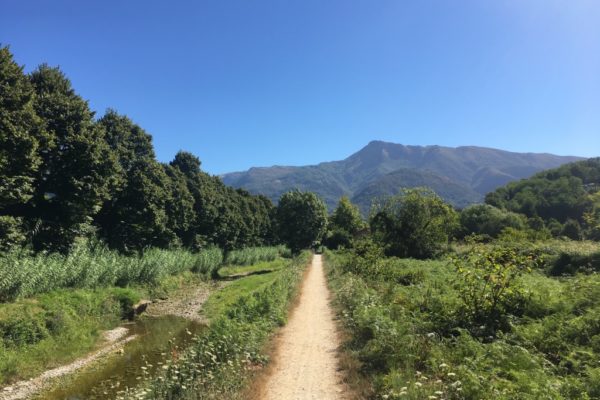
We reached the town just before lunchtime, having decided beforehand to stop here for the day and allow our bodies to mend. After coffee and a sandwich we went on our hunt for the pilgrim hostel just outside the center of town. As it turned out, we arrived between check-in windows, but a phone call with one of the women who runs the hostel cleared up the logistics, and she said we were welcome to leave our bags in the gated garden. We did so and, newly unencumbered, made our way back into town for a laid back lunch of pizza and beers at G&B (casual but fantastic, and exactly what we needed).
After a few hours of work and relaxation, we returned to the hostel to check in, do laundry, and get settled. It was a Sunday, meaning not much was open anyway, but we weren’t up for much more than a (very slow) stroll through the center of town, a glass of wine, and a plate of pasta for dinner. The past couple of days had taken a lot out of us, but as the evening wound down, the road that stretched before us seemed less insurmountable than it had even 24 hours before.
14 AUGUST: Camaiore [rest day]
We woke up bright and early, as planned, ready to tackle to the rest of the stretch to Lucca that lay before us. Part of the morning ritual that many pilgrims soon adopt is checking and tending to whatever foot ailments the constant walking may have brought about. Already dressed, packed, and fed, we were almost ready to go when in the course of assessing our feet when we discovered that Adam had, in fact, done a number on his. The multiple blisters had been painful the day before, but looking at them in the light of morning, it was clear they needed more treatment than our small first-aid kit was prepared to provide, and walking several kilometers before addressing them wasn’t an option.
Decision time. The pharmacy wouldn’t be open for another couple of hours, we had about 24 kilometers to walk to Lucca, and we preferably didn’t want to do so entirely in the heat of the early afternoon. After taking stock of our options and speaking with the hostel managers, we decided to stay an extra day in Camaiore. We could get what we needed from the pharmacy, Adam’s feet could begin to heal, and we could continue afterwards to Rome with more confidence that we’d actually make it all the way there.
Plenty of people talk about the profound realizations (spiritual, intellectual, emotional, etc.) that come from the experience of walking a pilgrimage. One thing I’ve realized so far—a big deal, coming from someone who loves to plan ahead—is the importance for flexibility and adaptability to reach a goal. It’s not the worst life lesson to be taking away from this trip, and here’s hoping it pays off by allowing us to make it to Rome in one piece!
Besides, the day off from walking wasn’t entirely a lost one. We accomplished a lot of errands, restocked our supplies, and finished out the day by watching the sunset on the patio of our hostel, while enjoying an encore take-away dinner of pizza and beer. Not the worst way to recuperate and take advantage of an extra day of relaxation.
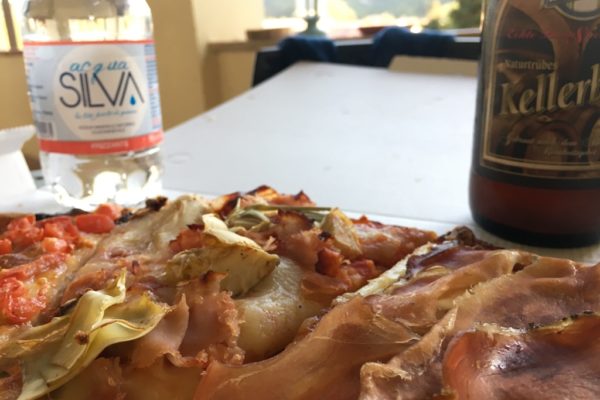
(to be continued…)
Share This: